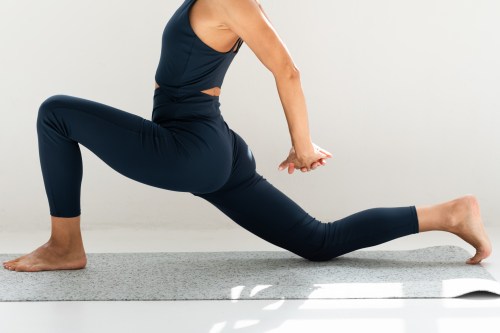Yoga really tests your balancing skills. From tree pose to extended side angle and handstands, practically half of a vinyasa flow involves bending your body and (hopefully) holding yourself up at the same time. When it comes to the different lunges in yoga, there’s one common mistake that could be making your balancing challenge even tougher than it needs to be.
Experts in This Article
co-founder of Sky Ting Yoga in New York City
certified integrative health coach and registered yoga and meditation teacher
Often, it’s easy to simply flow from downward dog straight into a lunge (like high lunge, warrior I, and warrior II) without much thought as to where your feet are placed. This is something that New York City-based yoga pro Lindsay Pirozzi sees all of the time, which can be behind your balancing struggles. “I think it’s unintentional, but more often than not, students are not aware of where to actually step,” she says. “So, stepping forward without thought, the feet typically land closer together.”
When your feet are close together and in line with each other, it becomes exceedingly harder to hold yourself up in a yoga lunge. Pirozzi likens it to standing on a tight rope. “That’s much more challenging than creating a wider base of support, where your feet are hip-width distance apart,” she says. This is especially helpful for beginners, but can also provide a boost to yogis of all levels. “The alignment in yoga postures can and should be modified to bring us more stability, clarity, and ease,” says Chloe Kernaghan, yoga instructor and co-founder of Sky Ting.
With more space between your feet in yoga lunges, you’ll also give more of a break to your hips. “For what we refer to as closed hip poses, like warrior I and high lunge, allowing feet to stay to their own side—usually in line with the hip socket or sitz bone—can help with balance and cause less distress in the hips and sacrum,” says Kernaghan. The key, though, is to not overdo it. Pirozzi warns not going too dramatically wide with your foot placement in yoga lunges. Her tip? Stick with about six inches apart, or hips-width distance.
And, since yoga looks different for everyone, don’t stress too much about whether your foot placement is not the same as your friend’s or your teacher’s. “As with much of the yoga practice, there isn’t one single right way to do a posture, and different lineages teach different practices,” says Kernaghan. “As a student, try out different techniques and see what makes the most sense for your body.”
To put this tip to work, try this 10-minute standing yoga flow that incorporates plenty of lunges:
Oh hi! You look like someone who loves free workouts, discounts for cult-fave wellness brands, and exclusive Well+Good content. Sign up for Well+, our online community of wellness insiders, and unlock your rewards instantly.
Sign Up for Our Daily Newsletter
Get all the latest in wellness, trends, food, fitness, beauty, and more delivered right to your inbox.
Got it, you've been added to our email list.











